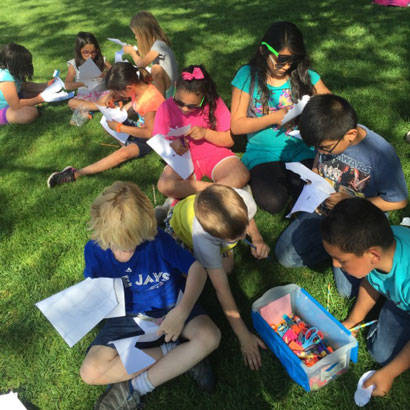
Childhood Attention Deficit Hyperactive Disorder (ADHD) diagnoses have been on the rise in the United States for the past few years. Between 2003 and 2011, the prevalence of the disorder in school-aged kids rose from 8.4 percent to 12 percent, a 42.9 percent increase. The significant rise in the number of children being diagnosed with ADHD has sparked a national debate on the best treatment for the disorder. Traditionally, treatments have focused heavily on the use of prescription medications, but an emerging body of research indicates that nature-based interventions could be an effective alternative to the use of pharmaceuticals.
ADHD is a brain disorder characterized by an ongoing pattern of hyperactivity and/or inattentiveness that can hinder work, play and academic pursuits in children. There are few interventions in existence for ADHD, but almost all of them include the use of prescription stimulants, such amphetamines (Adderall) and methylphenidates (Ritalin). While these medications have been proven to effectively treat ADHD, they also carry the potential for moderate-to-severe side-effects, including cardiovascular problems, abdominal pain and increased anxiety. The use of environmental education programming as an intervention has the potential to reduce the symptoms of ADHD in children without the potentially harmful side-effects of medications, while simultaneously providing kids with increased opportunities to connect to nature.
Some of the most important work on this topic has come out of the Human-Environment Research Laboratory at the University of Illinois. In a series of studies, researchers found that green outdoor spaces foster creative play, improve children’s access to positive adult interaction and help relieve the symptoms of attention-deficit disorders. They also found a direct correlation between the amount of nature and increased functioning — the greener the setting, the greater the benefits. “Activities in natural, green settings were far more likely to leave ADHD children better able to focus, concentrate,” they concluded.
While the body for research on pharmaceutical treatments for ADHD is large, there is little published research on using nature-based interventions, and more research is needed before nature-based intervention is accepted as an evidence-based solution. In an effort to address this dearth of research, Bellingham Parks and Recreation and Camp Fire Samish will launch a study to measure the impact of environmental education programming on foster children with ADHD.
Camp Fire Samish, an outdoor adventure camp in Washington state, has partnered with Bellingham Parks and Recreation Department to bring outdoor learning and adventure to children in the Pacific Northwest. Camp Fire Samish has piloted a few of these studies in the spring, and now that it has learned the benefits nature provides to young minds, it wants to act swiftly in the implementation of additional outdoor programming. The camp is in the process of developing an outdoor stewardship program, called INVEST (Implementing Nature’s Values Empowers Stewards of Tomorrow), which is run out of a local park.
We are determined to provide equal access to the great outdoors for all children, regardless of the socio-economic status of their parents, so scholarships are available to those who apply. We hope to build sustainable programs for all children in the community. Our growth and expansion allow for the addition of new, specific programs that cater to the needs of the community, as well as the funding to provide excellent programming. If we are successful in our endeavors, we could provide some bit of relief to the children who are the most vulnerable in our society. We’ve chosen to work specifically with foster children because of their general lack of family support.
Research has shown that the less support a child has, the higher the risk he or she has of developing behavior disorders. A 2001 study of 1,600 foster children in the United States found that 50 percent had a social, behavioral or emotional disorder and that about 25 percent of them had ADHD. In comparison, the American Psychiatric Association determined that 5-6 percent of children in the United States had ADHD. Clearly, there is a very alarming discrepancy between the national average of childhood disorders and the percentage of foster children that have them.
The goal of the study is to create measurable data in order to quantify the effectiveness of nature as an intervention for foster children with ADHD. We will use the Applied Behavior Analysis tool, a widely accepted methodology for assessing the effectiveness of an intervention on ADHD symptoms, to measure behavioral changes and intervention efficacy. It is used by special education departments in U.S. public schools and in numerous ADHD studies.
We intend to use the tool to construct a case study with Camp Fire Samish in Bellingham and Western Washington University in order to measure and record evidence that environmental education programming can reduce symptoms of the disorder as an alternative intervention to medication.
The case study will be run in early fall of 2017 and will consist of three sessions with 12 foster children in each. Behavior assessments will be administered at the beginning and end of the camp experience to measure growth. The foster parents will also be a surveyed before and after the study. We expect to produce published results, and hope that our case study will serve as a standardized method for collecting evidence-based data that park and rec agencies nationwide can use. We will attempt to answer the following questions:
1. Can environmental education programming cause a measurable reduction of ADHD symptoms in foster children?
2. If so, to what extent?
Most of the existing research, as positive and encouraging as it is, is correlative, not causal. This is why more research is needed from park and recreation agencies and environmental education providers on the preventive and therapeutic benefits from time spent in nature. If you’d like to learn how to go about conducting a similar study in your area, we’d be happy to offer some advice.
Maddie Dineen is the Environmental Education Program Coordinator, Camp Fire Samish at Bellingham Parks and Recreation.

